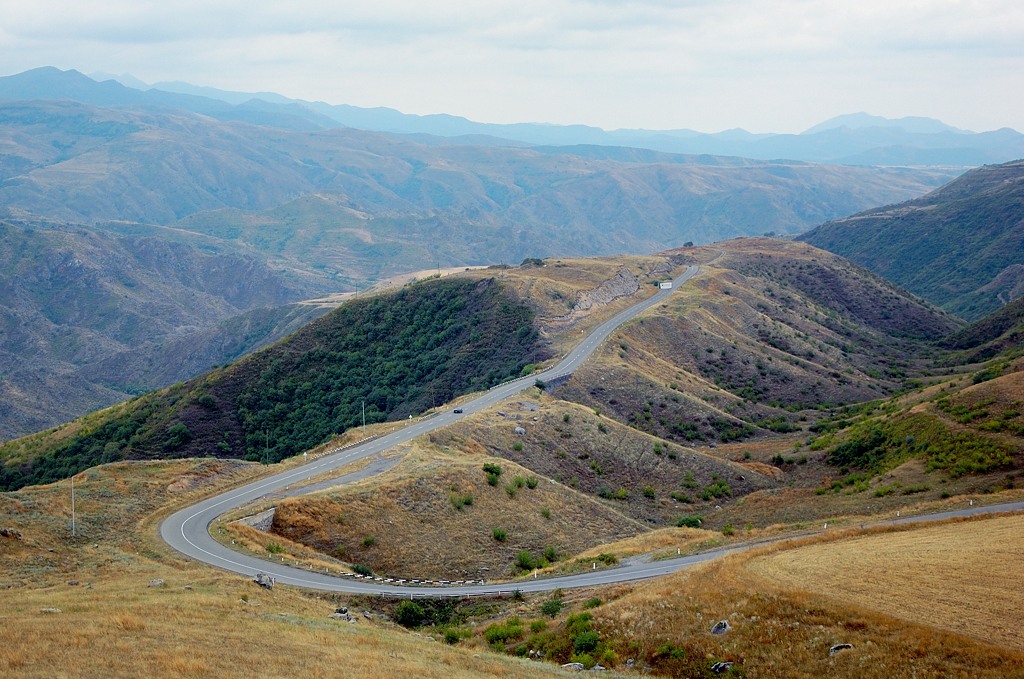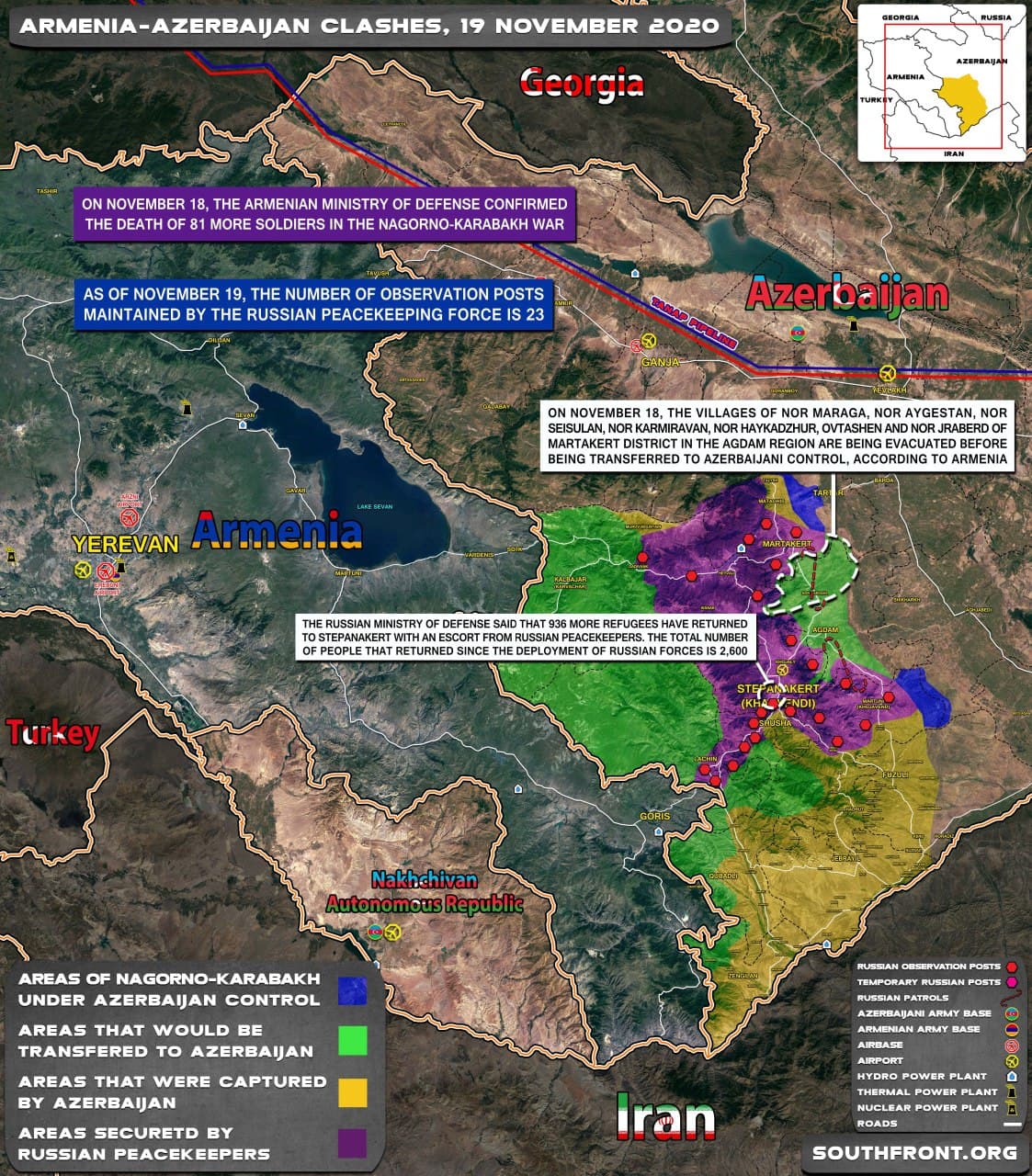The Nagorno-Karabakh war is over, at least for now, and since November 10th has been sealed due to the deployment and work of Russian peacekeepers.
As a result, by setting up their observation posts, the peacekeepers unblocked the transport corridors and this in turn leads to some prospects for the future.
Russian blogger Periskop provided an overview on the matter, in a blogpost.
His idea is to put aside the military-political results of the Karabakh War, and instead shift focus on the transport aspect.
The changes are quite extensive, and a more significant than those of 2014, and even those of 1994.
They could potentially greatly reshape freight and passenger flows in that region.
For the first time, in a while, several strategic directions that have been inactive for almost 30 years are unlocked at the same time, plus the plans of powerful players in this region for new corridors.
There are several most rudimentary observations that can be made:
- For the first time in its post-Soviet independence, Armenia will fully equip its own border and it will have to directly deal with the points of transport crossings on its border. Until now, it was protected by a large buffer zone and its eastern borders were conditional. And now – the situation has changed, since all border areas are transferred to Azerbaijan under the November 10th Almost throughout the entire East and South, the Armenians will have to work with the Azerbaijanis and, after some time, perhaps with the Turks. This map shows the scale of the problem.
- Regarding the provision of the peace deal that leaves a bit of Karabakh left with Armenia. The Lachin corridor has been “internationalized” and will be controlled by Russian troops. Nevertheless, everything is not so simple there: since the Azerbaijanis took the city of Shusha at the end of the war, the corridor’s approach to Stepanakert and northern Karabakh partially passes through the zone of control of the Azerbaijani army. In this regard, an interesting clause is made in the November 10 Agreement:
“[…] 6. The Republic of Armenia will return the Kelbajar region to the Republic of Azerbaijan by November 15, 2020, and the Lachin region by December 1, 2020. The Lachin corridor (5 km wide), which will ensure the connection of Nagorno-Karabakh with Armenia and at the same time will not affect the city of Shusha, remains under the control of the peacekeeping contingent of the Russian Federation.
As agreed by the Parties, in the next three years, a plan will be determined for the construction of a new route along the Lachin corridor, providing communication between Nagorno-Karabakh and Armenia, with the subsequent redeployment of the Russian peacekeeping contingent to protect this route. The Republic of Azerbaijan guarantees the safety of traffic along the Lachin corridor of citizens, vehicles and goods in both directions.”
The map below shows that the Lachin corridor passes at the foot of the mountain on which Shusha is located. Therefore, it is assumed that the corridor will be moved north to the other side of the valley, where country roads now pass. The map is Armenian, therefore Lachin is called “Berdzor” here. I have marked with a dotted line the possible relocation of the corridor section to the north.
HINT: The text in read reads – “Future construction will go around Shusha.”
- It is interesting that the route of communication with the remainder of Karabakh in the 10.11 Agreement was chosen without any alternative, despite the fact that there is also a second convenient link through the Zod Pass – a direct route through the East Sevan ridge. Until 2017, it was worse in terms of road class than the Lachin corridor, and did not function for all months. But now it is of a comparable class with Lachinsky and is year-round. But! This path is no longer listed in the document.
The cutout from the Armenian map of the region shows this corridor leading directly to Sevan. “Karvachar” is Kelbajar, which will soon be handed over to the winning side.
- Even more curious is the situation with the southern transport corridor, which is supposed to be unblocked under the Agreement and internationalized under the control of Russian forces:
“[…] 9. All economic and transport links in the region are unblocked. The Republic of Armenia guarantees the safety of transport links between the western regions of the Republic of Azerbaijan and the Nakhichevan Autonomous Republic with the aim of organizing the unimpeded movement of citizens, vehicles and goods in both directions. Control over transport communication is carried out by the bodies of the Border Service of the FSB of Russia.”
It is necessary to clarify that not only an automobile road, but also a railway passes along the border South. Part of it was built in 1936, and the connection with the old royal road in Julfa – in 1941. This corridor was abandoned in 1992, when the war cut as many as 4 places. Gradually, Armenia dismantled its plots, and Azerbaijan kept them up to Horadiz in the east, and within the Nakhichevan enclave.
But that’s not all! Iran, taking advantage of 30 years of anarchy and, in fact, a “no-man’s” buffer territory, quietly built the Khudaferin hydroelectric power station there and flooded about 15 km of the dismantled railway. Here is this piece, in a green box:
HINT: The green square shows an area flood as a result of the Iranian dam construction. The thick black lines show the deconstructed parts of the railroad in the area.
It is clear that the landscape there has seriously changed.
And it is so serious that after raising the water’s edge by 35-40 m, the new place for the line resembles the Circum-Baikal Railway – there it is necessary to cut a rocky corridor, it is super expensive. True, this most difficult section lasts only 8-9 km, but nonetheless.
Once there was an Agreement between the USSR and Iran of 1977, where this project was supposed to be done jointly. However, Iran, after the disappearance of the second side, gracefully put x …, oh, bolt on all this, and did what he wanted without taking into account the transit line. Azerbaijan did not control the land; Armenia did not care.
Now there is a transport-geographic dead end. By the way, it is not very clear why Azerbaijan kept quiet when Iran changed the landscape of the territory and unilaterally blocked the railway corridor.
Line of the flooding area – in red:
The landscape has changed so much that now it is not easy to continue the line. It approaches the Khudaferin hydroelectric station from below and rests against the dam.
The height of the level difference is 65 m. This means that the railway will have to be rebuilt to the hydroelectric power station for at least 10 km and raised to compensate for the height difference. And then either punch a tunnel through the rocks 6-7 km away, or punch a coastal corridor through, as in the Circum-Baikal Railway. All this is very expensive.
So, the railway along the Southern Corridor will obviously return to full operation quickly: it needs quite a bit of funds to be restored. The road, however, was moved to the north from the hydroelectric power station, and it is working. So they will use it. Interestingly, the reservoir was filled only in 2010, i.e. recently.
- Turkey, as a stakeholder, also wants to take advantage of the unblocking of transport links and has already declared the construction of a railway to the Nakhichevan enclave. Then you can use the Southern Highway Corridor through Zangezur, because the railway is still problematic (see above). Provision 10.11 explicitly declares in clause 9 the possibility of new links:
[…] By agreement of the Parties, the construction of new transport communications linking the Nakhichevan Autonomous Republic with the western regions of Azerbaijan will be provided.
Here is the general configuration of Turkey’s railway approaches to the Transcaucasus. As you can see, quite sparsely. The Van corridor to Iran is tied to a ferry and not a complete one. So the Ankara – Kars link is the only railway link to that region.
True, a new link with Georgia through Akhalkalaki was recently built. So far, it is very flawed and with a small capacity. But it is there. The Turks got a connection with Azerbaijan through Georgia, since the direct highway through Kars is blocked by Armenia, it has not been working for 27 years. The dismantled sections of the inactive Southern corridor along the Araks are also visible on the same map.
The green line shows a possible railway route to the Nakhichevan enclave. In principle, this is quite real. I looked at the terrain – the Turks need to build about 220 km of the railway from Sarikamish, but most of the route will pass near the Armenian border and bypass Mount Ararat. But what will happen in reality – the future will show in a 5-year perspective.
- The loss of the war by Armenia and the restoration of Azerbaijan’s control over its territories south of Karabakh along the border with Iran, oddly enough, can bring serious relief to Armenia itself – there is a possibility of its transit communication with Iran through Nakhichevan. It is inexpensive and quite simple: the problem section Ordubad – Horadiz with Iranian flooding is located to the east, and to reanimate communications, you only need to restore the dismantled border section of several kilometers. And that’s all. This can be clearly seen in the above map.
- The fate of the last Soviet link Armenia – Azerbaijan by the shortest route through Sevan – Agstafa is unclear. They had just finished building it when the Karabakh conflict began in 1988 and it worked, God forbid, for three years. At some level of normalization of relations, and it can be used. Also, there is still a dismantled branch to Stepanakert from Yevlakh, which can potentially be restored rather quickly.
In conclusion, it should be noted that with all the casualties and costs of the war of 2020, the unblocking of transport corridors can compensate for the damage in 5 years and reanimate trade relations of both Armenia (via Nakhichevan to Iran) and Azerbaijan with its enclave and further to Turkey.
The construction of new transit routes through Zangezur can also bring Armenia a purely commercial profit. As long as all strategic corridors will be guarded by the “forester” (i.e., directly by Russian troops), the possibility of cutting them is minimal.
Well, Armenia now also has a choice: either to reflect on its defeat and agree with the unpleasant geopolitical results of the war, but also with the parallel unblocking of transport links; or prepare its revenge and potentially lose all of Artsakh completely.
And one more important change, left behind the scenes of this review: the Russian troops and the Air Force, supplying the peacekeeping contingent, for the first time in 25 years received a direct air corridor from Russia through Azerbaijan, and not by a roundabout way through the Caspian Sea and Iran. Azerbaijan’s President Ilham Aliyev will be forced to open a land railway corridor for the supply of the Russian contingent. But currently, the future is uncertain and how things will transpire is still largely a mystery.
MORE ON THE TOPIC:















I am baffled and confused! Tommy had assured us that only with American intervention were such things possible!
Tommy, stop talinkg to gourself.
How much more would it have been a win-win and more corridors opened only if more villages and churches had been burned, more people killed and ethnically cleansed under the Russian sponsorship? What a logic! It seems to be such a bad thing that war ended.
CIA gives u LSD